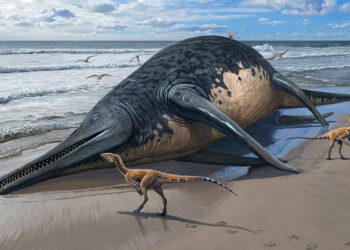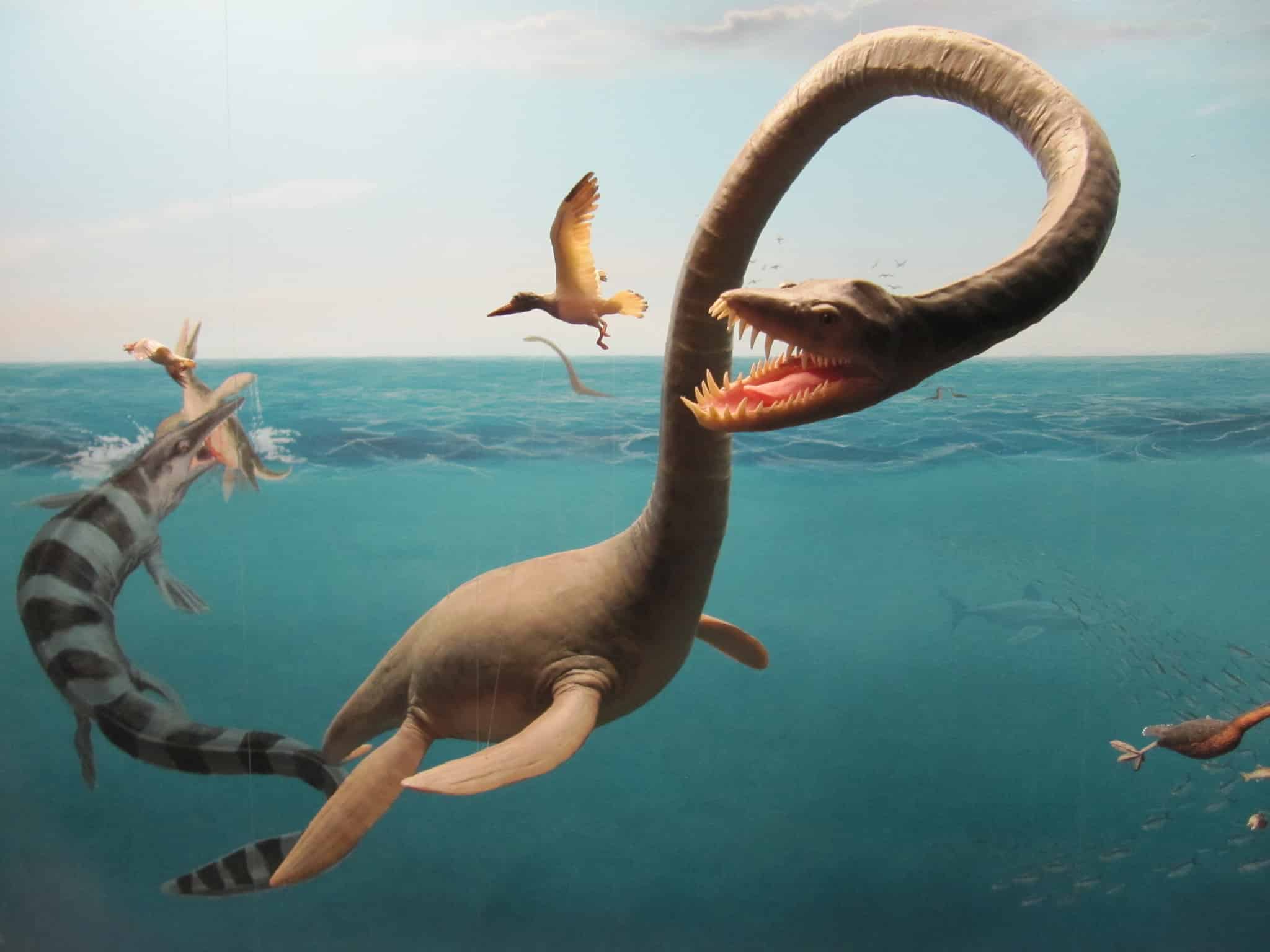
Do any water dinosaurs exist? Close your eyes and imagine a dinosaur. You probably see a fearsome Tyrannosaurus Rex stomping through a dense forest, or a herd of mighty triceratops, or a huge, long-necked diplodocus. Now, think of a dinosaur in water. Seems a bit off, right? Somehow, dinosaurs seem linked to the land.
But then you have the creatures that swam the Mesozoic oceans—like the long-necked plesiosaurs and sharp-toothed mosasaurs— so what’s up with that? Contrary to popular belief, true dinosaurs didn’t inhabit the seas. Instead, the mosasaur, the plesiosaur, and other titanic sea creatures were marine reptiles, not dinosaurs.
Still, some dinosaurs inhabited coastal areas and may have even swam from time to time. Let’s meet them.
Sea Dinosaurs: The Great Misconception
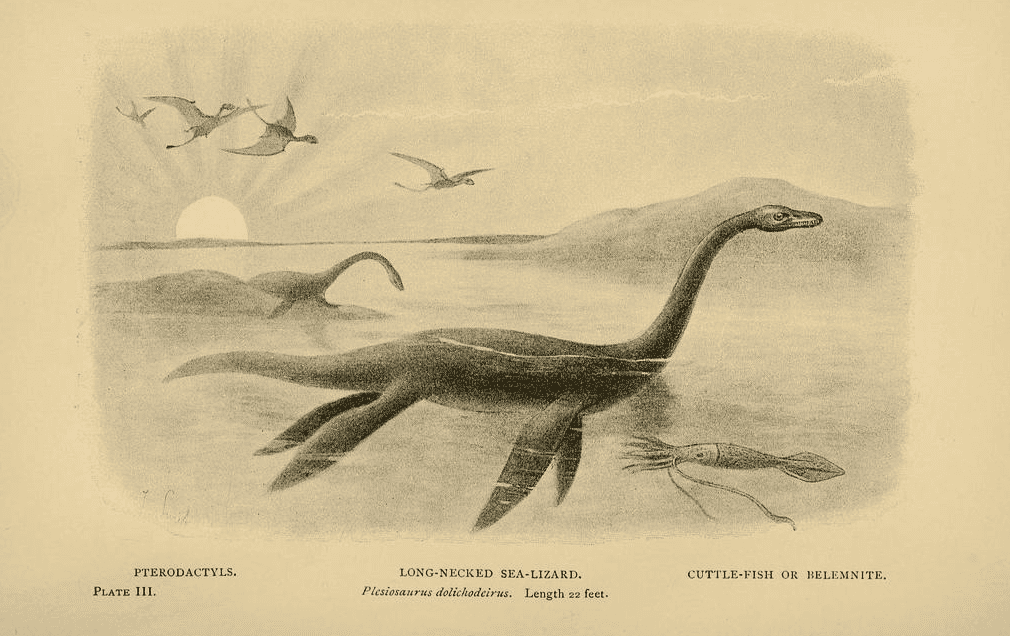
The term “sea dinosaurs” can be a bit misleading. Dinosaurs, as we typically think of them, lived on land. However, during the age of dinosaurs, there were many incredible marine reptiles that swam in the oceans. While they were not technically dinosaurs, they lived during the same time period and are often associated with them. These ancient marine reptiles are not to be confused with modern-day marine reptiles like sea turtles or marine iguanas.
It’s worth emphasizing that while these creatures lived at the same time as dinosaurs and were reptiles, they were not actually dinosaurs themselves. Dinosaurs are a specific group of reptiles that, by definition, are land-dwelling.
You can think of them as distant relatives, sort of like comparing dogs to foxes. Yet, despite this technicality, these aquatic giants captivate our imaginations just as powerfully as any T. rex.
Swimming Dinosaur: The Spinosaurus
The Spinosaurus was a true dinosaur — and a true predator. It wasn’t a marine dinosaur (remember, dinosaurs were land creatures), but it was pretty fond of water as well. Humans are also terrestrial creatures, but that doesn’t mean we can’t enjoy a good swim once in a while. Some dinosaurs were no different.
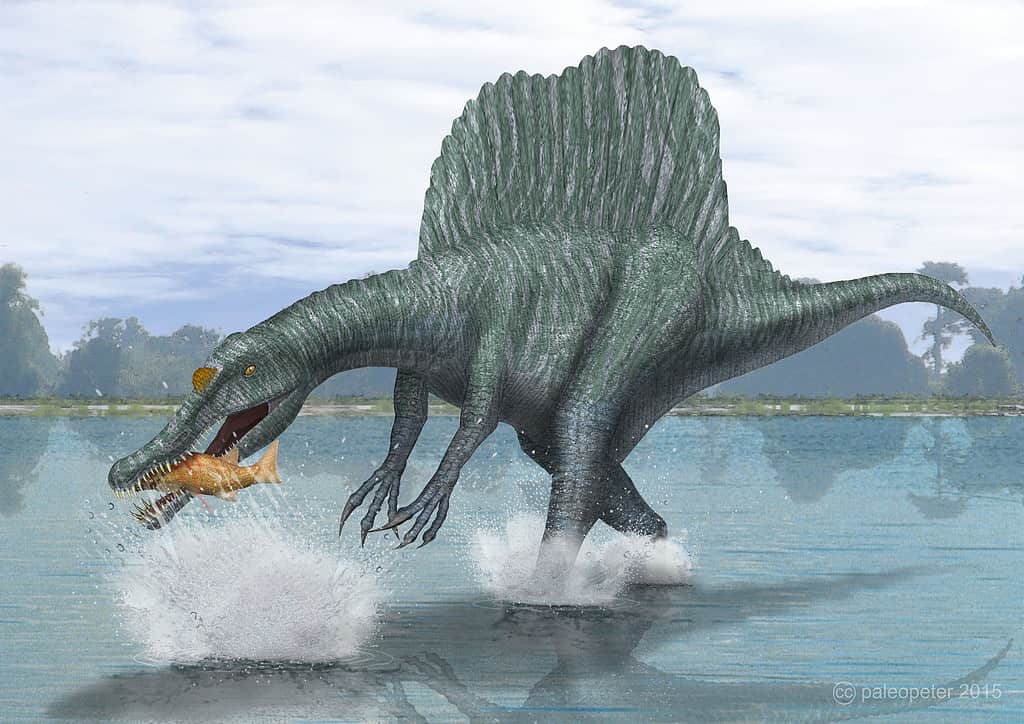
Spinosaurus is considered one of the largest, if not the largest, of all carnivorous dinosaurs. Estimates of its size vary, but it’s believed to have been around 48-59 feet (14-18 meters) in length and could weigh between 7 to 20 tons. The most striking feature is the tall “sail” on its back, formed by elongated neural spines coming from the back vertebrae.
The function of this sail is still a subject of debate among paleontologists. Some theories suggest it was used for temperature regulation, while others believe it might have been a display feature to attract mates or intimidate rivals. But the Spinosaurus is notable for something else as well. Unlike most other large theropods, Spinosaurus had adaptations suggesting it spent a significant amount of time in water.
Researchers have suspected for some time that dinosaurs like Spinosaurus did take a dip now and then. Fossil evidence shows specialized adaptations (webbed feet, nostrils positioned high on the skull, crocodile-like teeth suitable for catching fish, and dense bones which could have helped it in buoyancy control) that suggest these land-based giants might have been good swimmers.
Spinosaurus likely lived in humid environments near water — think tidal flats, mangrove forests, rivers. Not very different from how crocodilians today spend their lives.
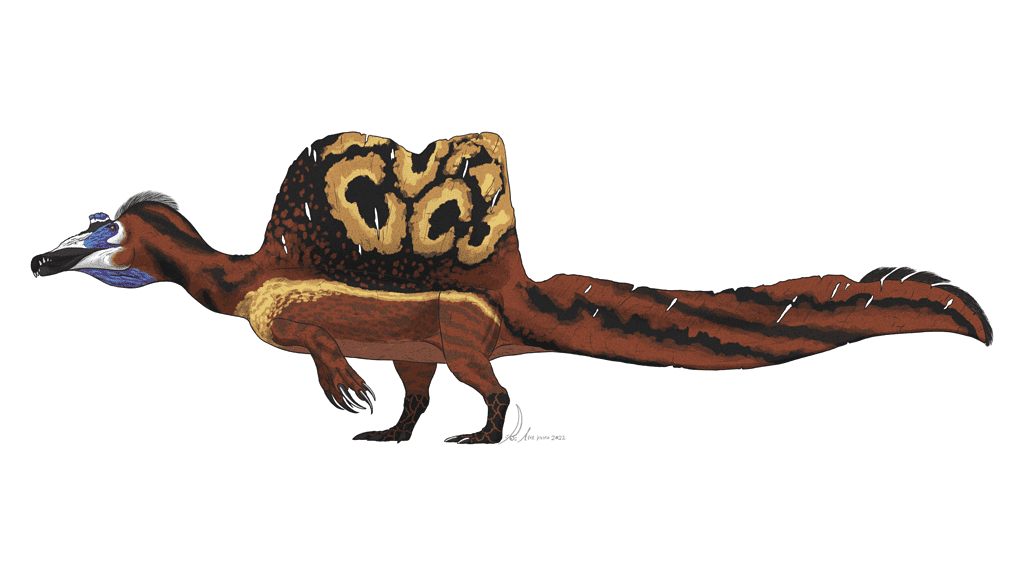
In the last decade, University of Portsmouth paleontologist and National Geographic Explorer Nizar Ibrahim has unearthed different parts of a Spinosaurus skeleton in North Africa’s Sahara Desert.
“We battled sandstorms, flooding, snakes, scorpions and more to excavate the most enigmatic dinosaur in the world and now we have multiple lines of evidence all pointing in the same direction – the skeleton really has “water-loving dinosaur” written all over it!”
Ibrahim and his team previously suggested that Spinosaurus could swim and actively pursue prey in the water. Some researchers disagree with this idea, but the recent study provides conclusive evidence that Spinosaurus was indeed an aquatic (or semi-aquatic) dinosaur.
“This dinosaur was actively pursuing prey in the water column, not just standing in shallow waters waiting for fish to swim by. It probably spent most of its life in the water.” The discovery also points to the possibility of a persistent and widespread invasion of aquatic habitats by relatives of Spinosaurus.
So Spinosaurus is the closest thing we know of to a swimming dinosaur. But remember, going for a swim doesn’t turn a dinosaur into a sea creature.
Now, let’s look at some other examples.
‘Water Dinosaur’ with Long Neck: Meet the Plesiosaurs
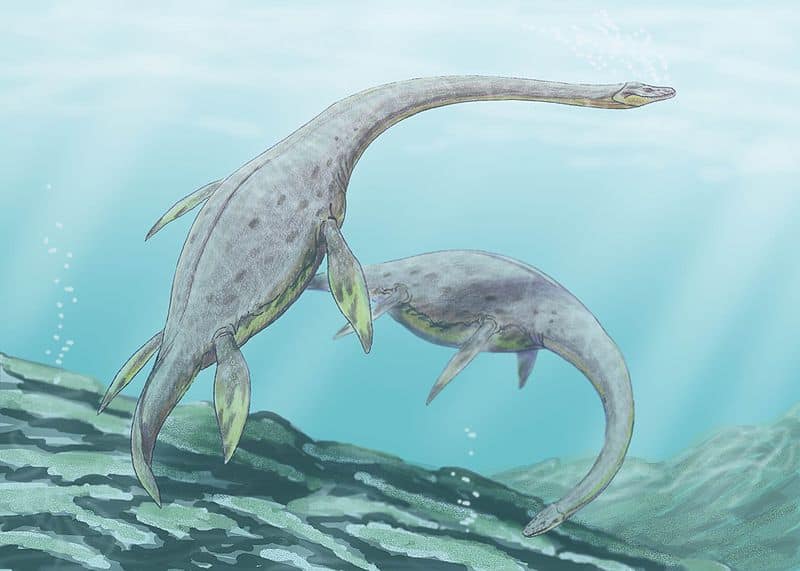
When people say “water dinosaur,” they probably refer to this one.
If you’ve ever seen the Loch Ness Monster‘s supposed “photographs,” you’ve got a basic idea of what a plesiosaur looked like. Picture a creature with a broad, turtle-like body, and an incredibly long neck, often greater than the length of its body. This mesmerizing design wasn’t just for show; it likely helped the plesiosaurs catch fish with remarkable efficiency.
Here’s where things get fascinating. These ancient reptiles didn’t chew their food. Instead, they used their needle-like teeth to snag prey and swallow it whole. Forget table manners; survival is the name of the game here.
Plesiosaurs first appeared in the latest Triassic Period, just over 200 million years ago. The size of plesiosaurs varied among species. Some were as small as 1.5 meters (5 feet) in length, while others, like the famous Elasmosaurus, could grow up to 14 meters (46 feet) long. They were carnivorous, feeding on fish and squid, and sometimes, other reptiles. Plesiosaurs still breathed air, but were otherwise adapted to an aquatic lifestyle, living, hunting, and spending most of their time in water.
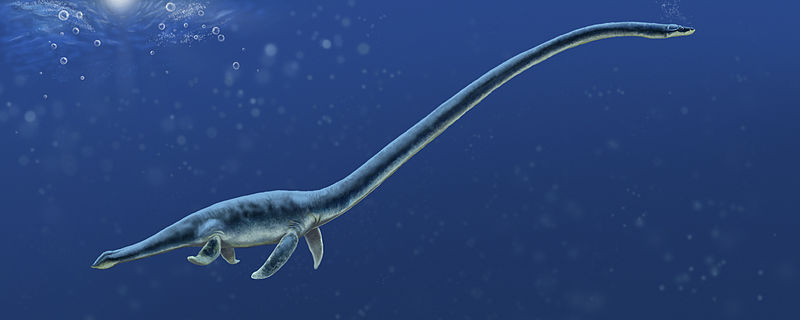
We don’t know everything about the plesiosaurs, however. Researchers are unsure what type of gait they would have had, or how fast they could swim. There’s also some speculation as to whether they would have crawled up on a beach to lay eggs, like modern turtles, or gave birth in water. We’re also unsure whether they hunted in packs or solitary.
But no, plesiosaurs were not dinosaurs: they were marine reptiles.
However, unlike many reptiles nowadays, they seemed to care for their young, and from the discovered fossils, we can deduce that social behavior in general was relatively complex.
Mosasaurus: The T-Rex of the Sea

The other reptile that people would commonly associate with a ‘sea dinosaur’ are the mosasaurs.
You can’t discuss water-dwelling giants without mentioning the mosasaur. These creatures were the apex predators of their time, boasting teeth that would make a great white shark green with envy. Unlike plesiosaurs, mosasaurs had a more streamlined body and an elongated, crocodile-like snout.
Mosasaurs breathed air, were powerful swimmers, and were well-adapted to living in the warm, shallow inland seas prevalent during the Late Cretaceous period. Their four limbs had evolved into flippers, aiding in their aquatic lifestyle.
These creatures had a double-hinged jaw and flexible skull, allowing them to consume large prey. This jaw was lined with rows of sharp, conical teeth, perfect for grasping slippery, fast-moving marine animals. Their diet primarily consisted of fish, but they also preyed on smaller marine reptiles, birds, and even sharks.
By the end of the Cretaceous period, mosasaurs were the dominant marine predators. However, their reign was cut short by the mass extinction event that occurred around 65 million years ago, which wiped out all non-avian dinosaurs and many marine species, including the mighty mosasaurs.
And here’s a fun fact for you: mosasaurs were actually related to modern-day monitor lizards. That’s right—think of the Komodo dragon, then imagine it bulked up, slapped on some fins, and took over the seas.
Largest ‘Water Dinosaurs’: The ichthyosaurs
The other iconic water reptiles from the age of the dinosaurs are ichthyosaurs.

Spanning a history of over 150 million years, these creatures played a prominent role in the prehistoric marine ecosystem. Their name, “ichthyosaur,” translates to “fish lizard” in Greek, which aptly describes their fish-like appearance. They were also very large. Some of these marine reptiles were comparable in size to modern cetaceans (whales).
Ichthyosaurs had a streamlined body, resembling modern dolphins or sharks, indicating a fast and agile lifestyle. Their adaptations for a life entirely at sea were numerous. They had a long snout filled with sharp teeth, ideal for snapping up fish and squid, which were their primary diet. Large, round eyes suggest that some species might have hunted in low-light conditions, possibly diving deep to chase their prey.
Ichthyosaurs also have the largest eye sockets of all known vertebrates, and fossil evidence suggests that they gave birth to live young, similar to modern-day whales. This adaptation meant they never needed to return to land, unlike some other marine reptiles of the time.
However, unlike other reptiles on this list, the ichthyosaurs didn’t live until the end of the Mesozoic period. They went extinct some 90 million years ago, way before the meteorite brought on the demise of the last dinosaurs (or to be technically correct, the demise of the non-avian dinosaurs).
The largest ichthyosaur and the largest marine reptile was the Late Triassic species Shastasaurus sikanniensis. It measured a whopping 21 m (69 ft) long and weighed 81.5 tons (180,000 lb) in weight.
Water Dinosaur Examples: A Roster of Legends
By now, you’re likely itching to meet more of these ancient swimmers. Yet again, these are not true ‘water dinosaurs’. Dinosaurs are land creatures. But for the lack of a better term (and because ‘reptiles that lived along with dinosaurs and sort of looked like dinosaurs and lived in water but weren’t exactly dinosaurs’ doesn’t sound that well), here are some more ‘water dinosaurs’ — including some of which we’ve looked at, and some we haven’t:
- Ichthyosaurs: Dolphin-like marine reptiles that lived during the Mesozoic era.
- Plesiosaurs: Known for their long necks and four large flippers. The famous Loch Ness Monster myth is often depicted as a plesiosaur.
- Mosasaurs: Large, predatory marine reptiles. They’re more closely related to monitor lizards and snakes than to dinosaurs.
- Nothosaurs: Marine reptiles with elongated bodies and long necks, they were the ancestors to plesiosaurs.
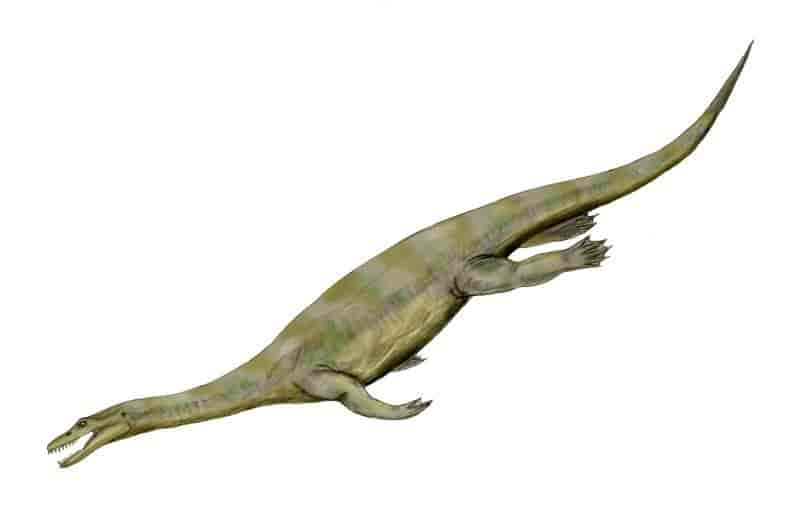
- Placodonts: Reptiles that were somewhat turtle-like in appearance, with bony plates and specialized for crushing shellfish.
- Thalattosaurs: These were medium-sized marine reptiles with elongated snouts, which they likely used to probe crevices for prey.
- Sauropterygians: This is a diverse group that included both nothosaurs and plesiosaurs, but also had other members:
- Eosauropterygians: Early members of this group, which included species like Lariosaurus.
- Thalattosuchians: These were marine crocodylomorphs (related to today’s crocodiles) that adapted to life in the sea. They included:
- Teleosaurs: Long-snouted and similar in appearance to modern gharials, but marine-adapted.
- Metriorhynchids: Fully marine crocodylomorphs with flippers instead of legs and a shark-like tail fin.
- Turtles: Ancient marine turtles known as Archelon were some of the largest turtles ever known. While modern sea turtles are not related to the aforementioned reptiles, the ancient marine versions often captivate imaginations in a similar way.
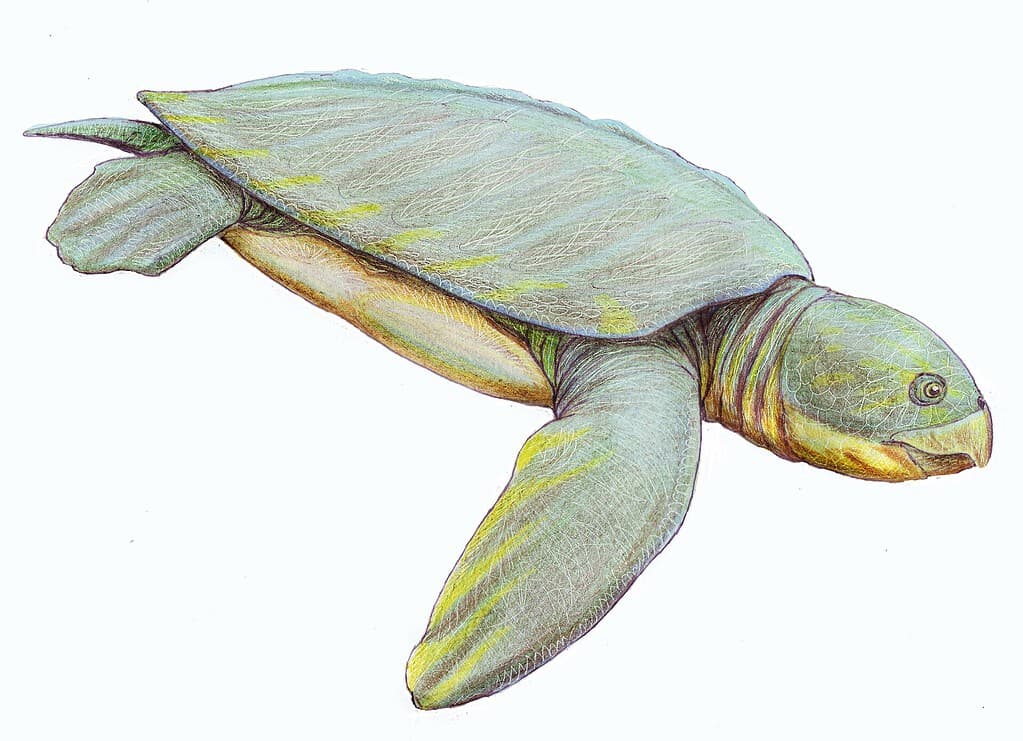
These are just a few examples. The Mesozoic seas were bustling with life, from tiny, agile hunters to lumbering leviathans. Each had its unique survival strategy, but all shared a world far removed from ours—a world worth studying and cherishing.
FAQ about dinosaur-age marine reptiles
The term “water dinosaurs” isn’t a scientific classification. It’s a colloquial term sometimes used to describe ancient marine reptiles that lived during the age of dinosaurs. These include creatures like ichthyosaurs, plesiosaurs, and mosasaurs, among others.
No, they were not dinosaurs. Dinosaurs are a specific group of land-dwelling reptiles. The marine reptiles, often colloquially referred to as “water dinosaurs”, are entirely separate from the dinosaur lineage.
Ichthyosaurs, plesiosaurs, mosasaurs, nothosaurs, placodonts, thalattosaurs, sauropterygians, and certain marine crocodylomorphs like thalattosuchians are some examples that would be colloquially called ‘water dinosaurs’.
Yes, many of these marine reptiles lived during the Mesozoic era, the same time as the dinosaurs. However, they occupied different niches, with these marine reptiles living in aquatic environments and dinosaurs primarily on land.
Most water dinosaurs were carnivors but their diets varied. Some, like ichthyosaurs, ate fish and squid. Others, like placodonts, fed on shellfish, and large predators like mosasaurs might have eaten smaller marine reptiles and large fish.
The term probably arises from their coexistence with actual dinosaurs and the impressive, often large and fearsome appearances of these marine reptiles. For the general public, they are reminiscent of the dinosaurs that lived on land.
No, the specific groups mentioned have all gone extinct. However, their distant relatives can be found in modern reptile species. For example, mosasaurs are related to today’s monitor lizards and snakes.
Some marine reptiles have distant modern relatives. As mentioned, mosasaurs are related to monitor lizards and snakes. Thalattosuchians are related to crocodiles. It’s important to remember that these relationships span millions of years, and the modern creatures are not direct descendants but share common ancestors.
Like many prehistoric creatures, the depictions can vary in accuracy. While some are based on the latest scientific understanding, others take creative liberties for entertainment purposes.
Many natural history museums around the world display fossils or reconstructions of these ancient marine reptiles. Some of the most famous museum collections include the The Natural History Museum, London, UK, the Smithsonian National Museum of Natural History, Washington, D.C., USA, and The American Museum of Natural History, New York, USA.
They’re not dinosaurs, but they’re just as amazing
So there you have it—the wonderful, waterlogged world of “water dinosaurs,” or more accurately, Mesozoic marine reptiles. They may not have been true dinosaurs, but they certainly deserve a place in our collective imagination, right alongside the T. rex and Triceratops.
It’s not just paleontologists who should care about these bygone behemoths. Understanding them enriches our comprehension of evolution, ecology, and the Earth’s history. Plus, let’s be honest: they’re just plain cool.
Keep looking to the oceans, my friends. Who knows what other ancient secrets they hold? Feel the waves, hear the ancient roars, and keep the spirit of exploration alive. Because when it comes to the mysteries of our planet, we’ve barely scratched the surface.
